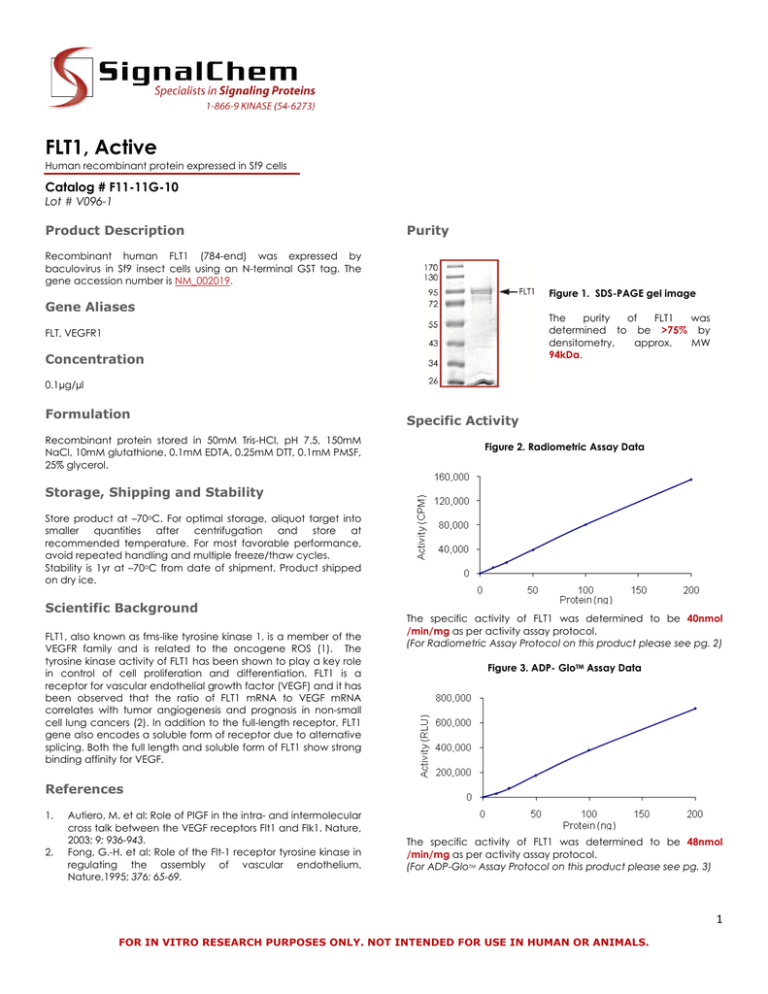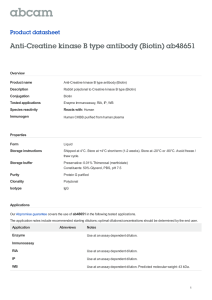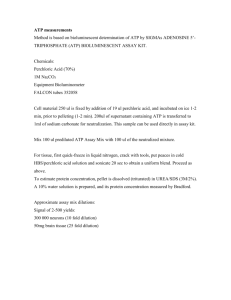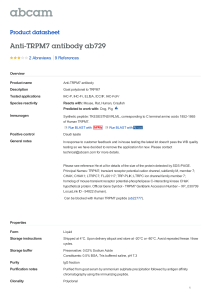FLT1 Kinase Datasheet Lot# V096-1
advertisement

FLT1, Active Human recombinant protein expressed in Sf9 cells Catalog # F11-11G-10 Lot # V096-1 Product Description Purity Recombinant human FLT1 (784-end) was expressed by baculovirus in Sf9 insect cells using an N-terminal GST tag. The gene accession number is NM_002019. Figure 1. SDS-PAGE gel image Gene Aliases The purity of FLT1 was determined to be >75% by densitometry, approx. MW 94kDa. FLT, VEGFR1 Concentration 0.1µg/µl Formulation Recombinant protein stored in 50mM Tris-HCl, pH 7.5, 150mM NaCl, 10mM glutathione, 0.1mM EDTA, 0.25mM DTT, 0.1mM PMSF, 25% glycerol. Specific Activity Figure 2. Radiometric Assay Data Storage, Shipping and Stability Store product at –70oC. For optimal storage, aliquot target into smaller quantities after centrifugation and store at recommended temperature. For most favorable performance, avoid repeated handling and multiple freeze/thaw cycles. Stability is 1yr at –70oC from date of shipment. Product shipped on dry ice. Scientific Background FLT1, also known as fms-like tyrosine kinase 1, is a member of the VEGFR family and is related to the oncogene ROS (1). The tyrosine kinase activity of FLT1 has been shown to play a key role in control of cell proliferation and differentiation. FLT1 is a receptor for vascular endothelial growth factor (VEGF) and it has been observed that the ratio of FLT1 mRNA to VEGF mRNA correlates with tumor angiogenesis and prognosis in non-small cell lung cancers (2). In addition to the full-length receptor, FLT1 gene also encodes a soluble form of receptor due to alternative splicing. Both the full length and soluble form of FLT1 show strong binding affinity for VEGF. The specific activity of FLT1 was determined to be 40nmol /min/mg as per activity assay protocol. (For Radiometric Assay Protocol on this product please see pg. 2) Figure 3. ADP- GloTM Assay Data References 1. 2. Autiero, M. et al: Role of PlGF in the intra- and intermolecular cross talk between the VEGF receptors Flt1 and Flk1. Nature, 2003; 9: 936-943. Fong, G.-H. et al: Role of the Flt-1 receptor tyrosine kinase in regulating the assembly of vascular endothelium. Nature,1995; 376: 65-69. The specific activity of FLT1 was determined to be 48nmol /min/mg as per activity assay protocol. (For ADP-GloTM Assay Protocol on this product please see pg. 3) 1 FOR IN VITRO RESEARCH PURPOSES ONLY. NOT INTENDED FOR USE IN HUMAN OR ANIMALS. Activity Assay Protocol Reaction Components Active Kinase (Catalog #: F11-11G-10) [33P]-ATP Assay Cocktail Active FLT1 (0.1μg/μl) diluted with Kinase Dilution Buffer III (Catalog #: K23-09) and assayed as outlined in sample activity plot. (Note: these are suggested working dilutions and it is recommended that the researcher perform a serial dilution of Active FLT1 for optimal results). Prepare 250μM [33P]-ATP Assay Cocktail in a designated radioactive working area by adding the following components: 150μl of 10mM ATP Stock Solution (Catalog #: A50-09), 100μl [33P]-ATP (1mCi/100μl), 5.75ml of Kinase Assay Buffer I (Catalog #: K01-09). Store 1ml aliquots at –20oC. Kinase Dilution Buffer III (Catalog #: K23-09) 10mM ATP Stock Solution (Catalog #: A50-09) Kinase Assay Buffer I (Catalog #: K01-09) diluted at a 1:4 ratio (5X dilution) with final 50ng/μl BSA solution. Prepare ATP stock solution by dissolving 55mg of ATP in 10ml of Kinase Assay Buffer I (Catalog #: K01-09). Store 200μl aliquots at –20oC. Kinase Assay Buffer I (Catalog #: K01-09) Substrate (Catalog #: I15-58) Buffer components: 25mM MOPS, pH 7. 2, 12.5mM βglycerol-phosphate, 25mM MgC12, 5mM EGTA, 2mM EDTA. Add 0.25mM DTT to Kinase Assay Buffer prior to use. IGF1Rtide synthetic peptide substrate (KKKSPGEYVNIEFG) diluted in distilled H2O to a final concentration of 1mg/ml. Assay Protocol Step 1. Thaw [33P]-ATP Assay Cocktail in shielded container in a designated radioactive working area. Step 2. Thaw the Active FLT1, Kinase Assay Buffer, Substrate and Kinase Dilution Buffer on ice. Step 3. In a pre-cooled microfuge tube, add the following reaction components bringing the initial reaction volume up to 20μl: Component 1. 10μl of diluted Active FLT1 (Catalog #F11-11G-10) Component 2. 5μl of 1mg/ml stock solution of substrate (Catalog #I15-58) Component 3. 5μl distilled H2O (4oC) Step 4. Set up the blank control as outlined in step 3, excluding the addition of the substrate. Replace the substrate with an equal volume of distilled H2O. Step 5. Initiate the reaction by the addition of 5μl [33P]-ATP Assay Cocktail bringing the final volume up to 25μl and incubate the mixture in a water bath at 30oC for 15 minutes. Step 6. After the 15 minute incubation period, terminate the reaction by spotting 20μl of the reaction mixture onto individual pre-cut strips of phosphocellulose P81 paper. Step 7. Air dry the pre-cut P81 strip and sequentially wash in a 1% phosphoric acid solution (dilute 10ml of phosphoric acid and make a 1L solution with distilled H2O) with constant gentle stirring. It is recommended that the strips be washed a total of 3 intervals for approximately 10 minutes each. Step 8. Count the radioactivity (cpm) on the P81 paper in the presence of scintillation fluid in a scintillation counter. Step 9. Determine the corrected cpm by removing the blank control value (see Step 4) for each sample and calculate the kinase specific activity as outlined below. Calculation of [P33]-ATP Specific Activity (SA) (cpm/pmol) Specific activity (SA) = cpm for 5μl [33P]-ATP / pmoles of ATP (in 5μl of a 250μM ATP stock solution, i.e., 1250 pmoles) Kinase Specific Activity (SA) (pmol/min/μg or nmol/min/mg) Corrected cpm from reaction / [(SA of 33P-ATP in cpm/pmol)*(Reaction time in min)*(Enzyme amount in μg or mg)]*[(Reaction Volume) / (Spot Volume)] 2 FOR IN VITRO RESEARCH PURPOSES ONLY. NOT INTENDED FOR USE IN HUMAN OR ANIMALS. ADP-GloTM Activity Assay Protocol Reaction Components ADP-GloTM Kinase Assay Kit (Promega, Catalog #: V9101) FLT1 Kinase Enzyme System (Promega, Catalog #:V3001) FLT1, Active, 10μg (0.1μg/μl) IGF1Rtide, peptide substrate, 1ml (1mg/ml) Reaction Buffer A (5X), 1.5ml DTT solution (0.1M), 25μl MnCl2 solution (2.5M), 25µl Ultra Pure ATP, 10mM (0.5ml) ADP, 10mM (0.5ml) ADP-GloTM Reagent (5ml) Kinase Detection Buffer (10ml) Kinase Detection Substrate (Lyophilized) Reaction Buffer A (5X) 200mM Tris-HCl, pH 7. 5, 100mM MgCl2 and 0.5 mg/ml BSA. Assay Protocol The FLT1 assay is performed using the FLT1 Kinase Enzyme System (Promega; Catalog #: V3001) and ADP-GloTM Kinase Assay kit (Promega; Catalog #: V9101). The FLT1 reaction utilizes ATP and generates ADP. Then the ADP- GloTM Reagent is added to simultaneously terminate the kinase reaction and deplete the remaining ATP. Finally, the Kinase Detection Reagent is added to convert ADP to ATP and the newly synthesized ATP is converted to light using the luciferase/luciferin reaction. For more detailed protocol regarding the ADP-Glo™ Kinase Assay, see the technical Manual #TM313, available at www.promega.com/tbs/tm313/tm313.html. Step 1. Thaw the ADP-Glo™ Reagents at ambient temperature. Then prepare Kinase Detection Reagent by mixing Kinase Detection Buffer with the Lyophilized Kinase Detection Substrate. Set aside. Step 2. Thaw the components of FLT1 Enzyme System, ADP and ATP on ice. Step 3. Prepare 1ml of 2X Buffer by combining 400µl Reaction Buffer A, 1µl DTT, 1.6µl MnCl2 and 597.4µl of dH20. Step 4. Prepare 1ml of 250μM ATP Assay Solution by adding 25μl ATP solution (10mM) to 500µl of 2X Buffer and 475µl of dH20. Step 5. Prepare diluted FLT1 in 1X Buffer (diluted from 2X buffer) as outlined in sample activity plot. (Note: these are suggested working dilutions and it is recommended that the researcher perform a serial dilution of Active FLT1 for optimal results). Step 6. In a white 96-well plate (Corning Cat # 3912), add the following reaction components bringing the initial reaction volume up to 20μl: Component 1. 10μl of diluted Active FLT1 Component 2. 5μl of 1mg/ml stock solution of substrate Component 3. 5μl of 2X Buffer Step 7. Set up the blank control as outlined in step 6, excluding the addition of the substrate. Replace the substrate with an equal volume of distilled H2O. Step 8. At the same time as the FLT1 kinase reaction, set up an ATP to ADP conversion curve at 50µM ATP/ADP range as described in the ADP-Glo™ Kinase Assay technical Manual #TM313. Step 9. Initiate the FLT1 reactions by the addition of 5μl of 250μM ATP Assay Solution thereby bringing the final volume up to 25μl. Shake the plate and incubate the reaction mixture at 30oC for 15 minutes. Step 10. Terminate the reaction and deplete the remaining ATP by adding 25μl of ADP-GloTM Reagent. Shake the 96-well plate and then incubate the reaction mixture for another 40 minute at ambient temperature. Step 11. Add 50μl of the Kinase Detection Reagent, shake the plate and then incubate the reaction mixture for another 30 minute at ambient temperature. Step 12. Read the 96-well reaction plate using the Kinase-Glo™ Luminescence Protocol on a GloMax® Microplate Luminometer (Promega; Cat # E6501). Step 13. Using the conversion curve, determine the amount of ADP produced (nmol) in the presence (step 6) and absence of substrate (Step 7) and calculate the kinase specific activity as outlined below. For a detailed protocol of how to determine nmols from RLUs, see ADP-Glo™ Applications Database at http://www.promega.com/applications/cellularanalysis/cellsignaling.htm Kinase Specific Activity (SA) (nmol/min/mg) (ADP (step 6) – ADP (Step 7)) in nmol) / (Reaction time in min)*(Enzyme amount in mg) 3 FOR IN VITRO RESEARCH PURPOSES ONLY. NOT INTENDED FOR USE IN HUMAN OR ANIMALS.




